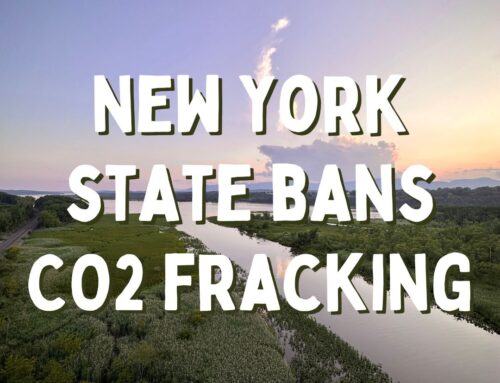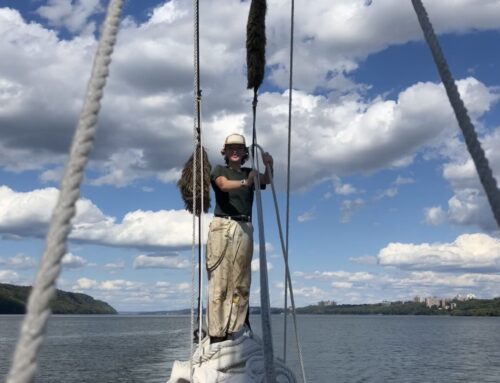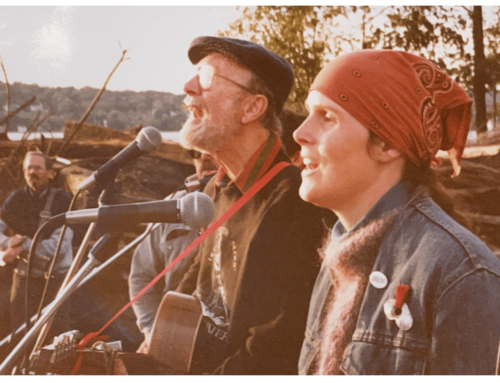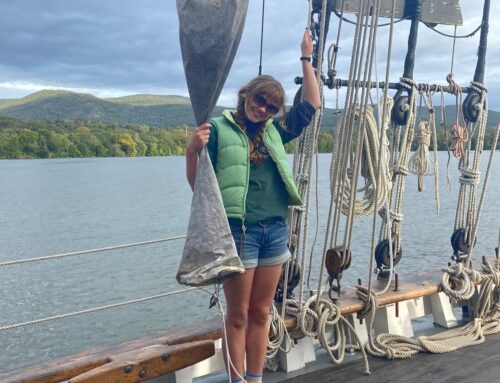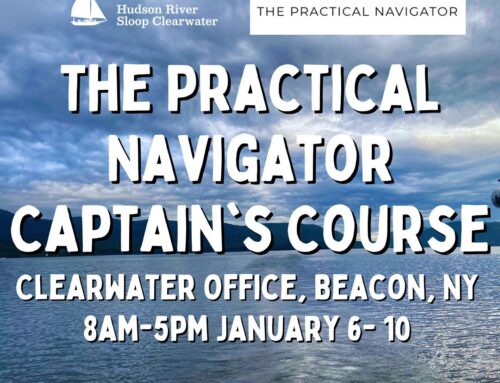HUDSON VALLEY – With a new governor coming to Albany and the Obama administration expected to announce plans shortly for its America’s Great Outdoors (AGO) Initiative—leaders of Hudson River Sloop Clearwater, Riverkeeper and Scenic Hudson today unveiled an action agenda for how a federal-state-local partnership with business and nongovernmental organizations could help restore the region’s economy and enhance its quality of life to attract green businesses and jobs.
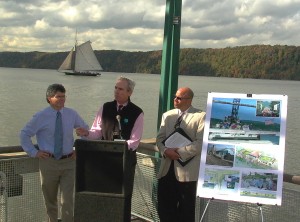
Paul Gallay, executive director of Riverkeeper, Ned Sullivan, president of Scenic Hudson, and Jeff Rumpf, executive director of Clearwater outline an environmental action agenda for the Hudson Valley at an October 14th press conference at Yonkers Recreation Pier
Gathering at the Yonkers Recreation Pier along the Hudson River, the environmental leaders—Jeff Rumpf, executive director of Clearwater; Paul Gallay, executive director of Riverkeeper and Hudson Riverkeeper; and Ned Sullivan, president of Scenic Hudson—highlighted the significance of this moment in time to begin to cultivate innovative public-private partnerships. This August the significance of the region’s natural resources was brought to the level of national prominence when federal officials, including U.S. Secretary of Agriculture Tom Vilsack and top representatives from the U.S. Department of Interior and Environmental Protection Agency (EPA), conducted a listening tour—one of only 26 nationwide—in the Hudson Valley as part of the AGO Initiative.
Leaders of the three organizations called on gubernatorial and legislative candidates to publicly show their support for a healthy environment as the foundation of a job-creating economic recovery. A concise action agenda for New York State that will restore our lands, waters and opportunities to reconnect urban areas with the great outdoors is urgently needed, they said. The leaders also outlined a companion agenda for federal action to complement the state’s role. In this economy, federal, state and local partnerships with the region’s business and nonprofit leaders are needed to take advantage of the unique, nationally significant landscapes that serve as an international tourism destination, attract new business investments and offer respite for the one in 12 Americans who live within a one-hour drive of the Hudson River.
“The young people of the Hudson Valley have spoken,” said Mr. Rumpf. “Our recommendations come from the 300 youth who came to take part in the America’s Great Outdoors listening sessions on August 5th in Hyde Park. We are at a crucial point in time where we must support our youth and give them the means to not only access the environment, but also the tools to address the environmental issues they as a generation face. This can be done through environmental education, training and hands-on experiences with nature that lead to green careers in our emerging green economy; essentially putting the ‘eco’ into the economy. It is imperative that the Obama administration and legislators at the local, state and federal levels endorse these environmental agendas for a sustainable future for our youth and for the future health and economic sustainability of our country.”
Riverkeeper, Clearwater and Scenic Hudson unveil an action agenda
“A healthy Hudson equals a vibrant, thriving economy,” stated Mr. Gallay. “Unfortunately, this cannot become a reality with a state Department of Environmental Conservation that has been crippled by budget cuts and pending staff layoffs which would set the agency back to its lowest levels since the 1980s. We need our next governor to do two things: heed the call to invest in infrastructure that will keep pollution out of our river and drinking water supplies and provide the DEC with the resources necessary to enforce our environmental laws. Not to do so will jeopardize a sustainable, economic future for our valley.”
“The lands and parks of the Hudson Valley are one of the key assets we have in attracting green jobs and new businesses to the region. Government, business and environmental groups have a shared interest in protecting the key natural resources that are the foundation of our future prosperity,” said Mr. Sullivan.
ACTION AGENDA FOR A HEALTHIER, MORE PROSPEROUS HUDSON VALLEY
Issue: Key population centers—particularly lower-income and minority groups within our region’s cities—are disconnected from the economic and recreational potential of the river.
Risk/Benefits:
· Noted author Richard Louv (Last Child in the Woods, Algonquin Books of Chapel Hill, 2005) used the term “nature deficit disorder” to describe a host of issues including attention disorders, obesity and depression attributable to a lack of experience with nature.
· According to a recent study through the University of Illinois, Chicago, more and more children are not experiencing the outdoors, leading to a detachment from nature and a trend in unhealthy lifestyles. Participation in nature activities is down 18 to 25 percent since peak levels (National Academy of Sciences—Oliver Pergams, University of Illinois, Chicago, Feb. 2008). “The replacement of vigorous outdoor activities by sedentary, indoor videophilia has far-reaching consequences for physical and mental health, especially in children,” he said. “Videophilia has been shown to be a cause of obesity, lack of socialization, attention disorders and poor academic performance.”
· The Hudson Valley is one of the most diverse regions in the world. Its post-industrial era cities have suffered the most economically, yet the region offers the potential to create urban-based cores that will establish a national model for green cities programs, which include aspects such as watershed-management practices, solutions for transportation and development pressures, and reducing the local and regional carbon footprint of existing urban infrastructure.
· The National Science Board of the National Science Foundation confirms the importance of environmental education to student learning in its 2000 report, “Environmental Science and Engineering for the 21st Century,” stating that “The twin goals of learning are to acquire knowledge and gain skills such as problem solving, consensus building, information management, communication, and critical and creative thinking.”
State Action:
· Prioritize Clearwater’s Next Generation of Environmental Leaders pipeline of programs, and support and advocate the Hudson River as a vital resource for environmental education.
· Prioritize development of a NYS Environmental Literacy Plan that establishes the Hudson River as a great learning resource and creates a pipeline of new green leaders through support and advocacy for comprehensive environmental-education programs.
· Shift focus of state investments in infrastructure to create a sustainable economy based on building eco-friendly green cities that provide physical access to the river, thereby creating green jobs.
· Restore funding for the Hudson River Estuary Action Agenda to 2007-8 levels.
Federal Action:
· Pass the No Child Left Inside legislation. No Child Left Behind’s emphasis on testing must be balanced with getting kids actively engaged with nature. Our policy is No Child Left On-land: connect kids directly to an ecologically and historically important river—the Hudson.
· Support the Youth Division request to the Department of Interior for Clearwater’s proposed Next Generation of Environmental Leaders pipeline of programs, “Local Solutions for a National Challenge,” and a riverwide initiative combining state, public, private and nonprofit entities to activate the youth of the Hudson River Valley, with a goal of establishing a national model in the next three years.
· Make changes in the formal educational system to help all students, educators and educational administrators learn about the environment, the economy and social equity as they relate to all academic disciplines and their daily lives.
· Increase funding for the Environmental Protection Agency’s Office of Environmental Education from the President’s FY 2011 funding level of $9M to $14M in FY 2012.
· Support the state’s Department of Environmental Conservation’s (DEC) Hudson River Estuary Program that provides resources for educators, students and families to learn about the Hudson, including outdoor programs, lesson plans, posters, education centers, exhibitions and interpretive materials for key river issues.
Issue: Our waters—essential for their commercial and habitat value, public health benefits and quality of life that they provide—are not fishable or swimmable.
Issue: Our waters—essential for their commercial and habitat value, public health benefits and quality of life that they provide—are not fishable or swimmable.
Risk/Benefits:
· According to the DEC, every year old sewers flooded by stormwater release more than 27 billion gallons of untreated sewage into New York Harbor alone. An inadequate sewage treatment infrastructure jeopardizes the viability of current and future businesses, stymies economic growth and threatens the quality of life for New York State residents.
· PCBs continue to contaminate the Hudson River for nearly 200 miles. Aside from injuries to human health, PCB exposure threatens substantial economic development along the upper Hudson, wildlife (including striped bass, once the basis of a $40-million annual commercial fishery), surface and groundwater sources communities depend on for drinking water, and productive agricultural soils.
· This past August, the Riverkeeper Water Quality Testing Program showed that 10 out of 75 sample sites along the Hudson River had unacceptable Enterococcus counts, a key indicator of sewage contamination. Problem areas included the Kingston sewage treatment plant outfall, sites above and below the Troy Dam/Lock and Esopus Creek. County departments of health in river communities are not testing the water with the frequency needed to serve the public health. The results of the testing they conduct are often not released to the public, and when they are, the data is often averaged in ways that obscure important local details.
State Action:
· The new governor and legislature need to be fair and responsible with the budgets of environmental agencies. Action must be taken to restore state agency operations, staff and capital budgets so they can protect drinking water and aquatic habitat, clean up toxic sites and brownfields to create new business opportunities, comply with legal mandates and continue to generate important revenue for the state.
· The quality and quantity of water in the Hudson River and its tributaries must be consistently tested and reported by New York State, allowing the public to safely recreate in a Hudson that is free of sewage from outdated stormwater and wastewater infrastructure. The DEC Hudson River Estuary Program’s Action Agenda must be fully implemented to achieve this important goal.
· The state must robustly support removal of toxic PCB-laden sediments from the upper Hudson River under the Superfund Law and work to restore fish populations in the river and in other state’s jurisdictions to revive our recreational fishery and consider reestablishing its commercial potential.
Federal Action:
· The Obama administration and the EPA must hold General Electric accountable for cleanup of toxic PCBs the company dumped in the Hudson.
· Create a Clean Water Trust Fund to finance repair and upgrade of existing drinking water/stormwater/sanitary systems.
· Expand the programmatic focus of the New York/New Jersey Harbor Estuary Program to the head-of-tide in Albany to provide for comprehensive management and restoration of natural resources and public access opportunities along the Hudson.
· Ensure that clean energy provided by modern, state-of-the-art power plants comes with updated pollution-control technology that doesn’t leave us with fouled air or a damaged river.
(more)
Page 4, Environmentalists Outline Vision for Partnering with Government
Issue: Public underinvestment in parks, farmland and natural-resource management threatens to undermine job opportunities, public health and economic recovery.
Risk/Benefits:
· Parks and open space boost the Hudson Valley’s $4.7-billion tourism industry—responsible for 80,000 jobs—and attract new businesses. Yet the state’s commitment to land conservation has dwindled to 30 percent of 2009 levels, while less than 2 percent of federal conservation funding in New York has been dedicated to protecting the valley’s world-class landscapes.
· Farms support a $530-million regional agricultural industry and are a primary supplier of fresh produce to New York City. Prior to the economic downturn the valley was losing nearly 50 acres of productive farmland each day to sprawling development. New York State’s commitment to farmland protection has withered, with $70 million of payments overdue to farming families.
· The Hudson Valley is home to over 180 rare or imperiled species whose future is uncertain— in the next decade the region will be home to four of the state’s fastest growing counties and this threatens to fragment critical forest, farmland and wetland habitats, also essential for safeguarding communities’ drinking-water supplies.
· New York State currently ranks 49th in the nation on its per capita investment in the environment. In previous economic downturns, innovative leaders understood the importance of environmental investments and created the Palisades Interstate Park and other gems of the state. A new investment in open space and parks could leverage private investments, create new jobs and enhance the livability of our communities—there is great potential in Yonkers, Sleepy Hollow, Cold Spring and Beacon, in particular.
State Action:
· New York State should meet its fundamental obligations to provide sustainable environmental protection for the Hudson Valley. We must move toward spending the national average (2 percent) of the state budget on the environment by 2015.
· The state’s Environmental Protection Fund should be a “lock box” with funds limited to its original legislative purposes. Funding dedicated to the environment should be spent on the environment and not swept into the state’s General Fund to balance the budget.
· The backlog of projects for farmland and open space protection, Hudson Estuary management and waterfront revitalization should be completed and the state should move forward with new projects that benefit communities, promote health and create jobs.
· Support for the Hudson River Valley Greenway agency to develop a heritage trail on both sides of the river from Albany to New York City that affords walking, kayaking/canoeing and other recreational opportunities and ways to experience history in a region designated by Congress as a National Heritage Area.
· The state should identify and support model projects that bridge environmental protection, park creation and economic development.
Federal Action:
· Support for a $100 million appropriation for farmland protection in the Hudson Valley in the 2012 Farm Bill, with particular focus on protecting the land base of the Hudson Valley’s diverse agriculture.
· Fully fund the Land and Water Conservation Fund (LWCF), Highlands Conservation Act (HCA) and Coastal and Estuarine Land Conservation Program. Private land trusts should be eligible to directly receive funds to conserve recreational and working landscapes, scenic and estuarine lands.
· Pass legislation making the enhanced federal conservation easement tax incentive permanent.
· The Hudson River Valley Special Resources Study Act has passed the House of Representatives. The Senate should do its part to pass the legislation and ensure it is signed by President Obama.
###

